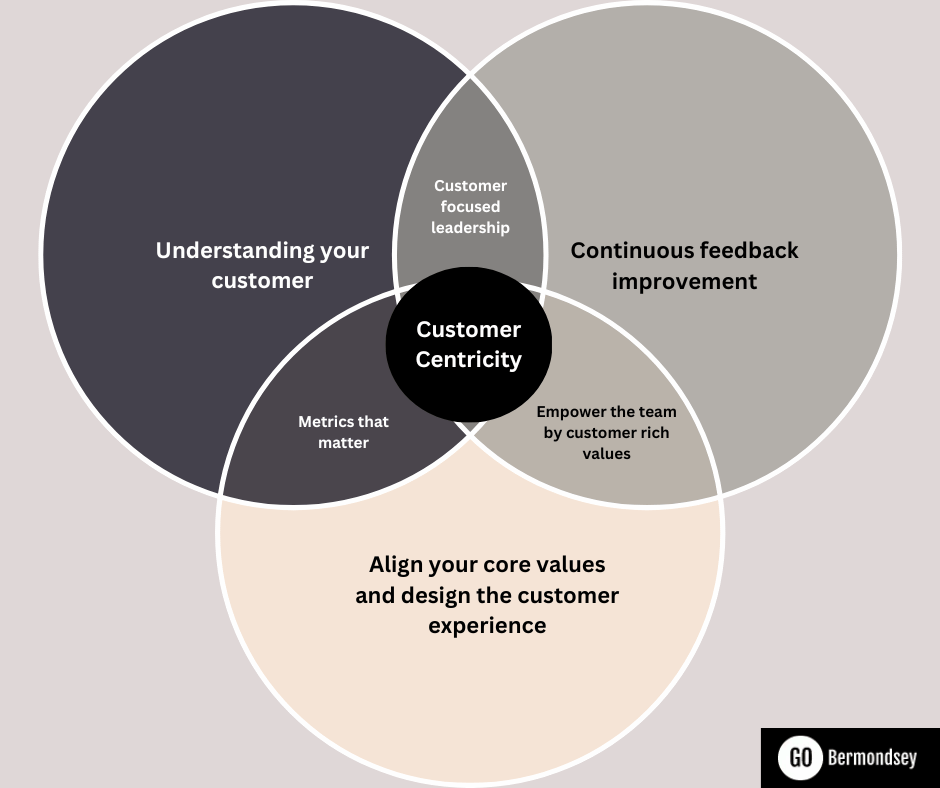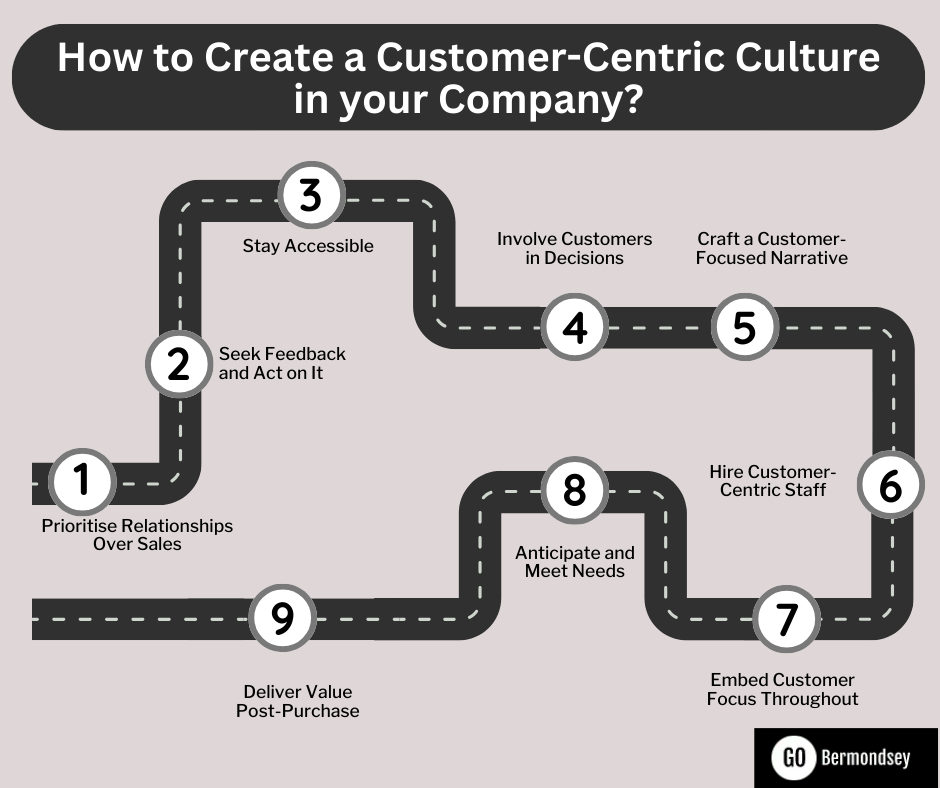How to Build a Customer-Centric Culture in Your Business?
February 26, 2024A customer-centric culture aims to boost profitability and gain a competitive advantage by cultivating highly positive experiences for customers.
A customer-centric culture aims to boost profitability and gain a competitive advantage by cultivating highly positive experiences for customers.
Customer is king may sound like a cliché, but this age-old adage rings truer than ever in today’s digital economy. With endless options at their fingertips, modern consumers hold immense power. Therefore, winning their loyalty requires putting them at the heart of your business.
In fact, Forrester research reveals that customers are willing to pay 50%-200% more if the company is focused on providing solutions for their pain points. Additionally, positive customer experiences (CX) can boost revenue by a staggering 5.7 times.
How can you tap into these opportunities and maximise growth through customer loyalty and advocacy? This article explores valuable insights and strategies for maximising growth through enhanced customer loyalty and advocacy.
Customer-centric culture refers to a business ethos where every aspect of operations revolves around satisfying customer needs and preferences. The organisation’s customer-centric culture prioritises cultivating highly positive experiences for customers throughout the entire pre-sales, sales, and after-sales journey. This strategy aims to boost profitability and gain a competitive advantage in the marketplace.
According to a report, a mere 14% of marketers perceive customer-centricity as their distinctive edge in the market. However, this figure declines to 11% concerning effectively conveying this edge to customers, indicating a significant gap in communication strategies.

An example is John Lewis Partnership, a UK retailer renowned for its customer-centric approach. They empower employees to make decisions focused on customer satisfaction, such as their never knowingly undersold policy, ensuring customers receive the best value. John Lewis fosters a culture of listening to customer feedback, adapting services accordingly, and prioritising long-term relationships over short-term profits. This dedication to putting customers first has earned them loyalty and trust, illustrating the power and impact of a customer-centric culture.
A customer-centric culture refers to one where the customer is placed at the core of every process, interaction and decision. In doing so, companies are best positioned to attract new customers while retaining existing ones. Here is how a customer-centric culture can help your company grow:
CLV refers to the period for which a customer continues taking services from a business. By listening to customer needs and providing helpful solutions, companies build engagement and long-term relationships with them. This leads to a higher CLV.
Satisfied and loyal customers become vocal advocates, referring companies to potential clients. A customer-driven culture can create customers who share positive word-of-mouth both organically and through their social media platforms.
Consistently delivering positive experiences throughout the customer journey conveys loyalty to the customer. In turn, they are more likely to return as the company provides solutions to their problems.
Customer feedback is an important element of a customer-centric company. Their feedback can help identify gaps in the company’s services. This feedback enables companies to improve their CX and operate more efficiently.
Also read, How flexibility drives productivity in a hybrid workspace?
The CMO Council reveals that only 14% of marketers think that customer centricity is a hallmark of their companies, and just 11% believe their customers would agree with that viewpoint. Bridging this gap between an organisation’s perception of customer centricity and the customer’s reality is a challenge that most companies face.

Therefore, by following these nine proven strategies, you can foster a customer-centric culture in your company:
The Harvard Business Review points out that most organisations struggle to create a customer-centric culture because they are highly sales-driven. When your company shifts its focus from sales to the real problems of the customers, only then can it provide services your customers actually need.
The only way for a company to know whether its services are driving a positive CX is through feedback. This feedback will provide organic insights into what your customers expect.
Meeting those expectations is the very goal of customer centricity. Take the example of Charles Schwab. By focusing on customer feedback, Charles Schwab saw tangible gains. Their revenues rose by 11% and customer satisfaction scores on surveys increased by 25%.
Accessibility is the key to meaningful communication with your customers. For instance, Zappos has one of the best call centres globally. They made this happen by facilitating natural conversations and steering away from scripts when talking to the customers.
Even though only 5% of their sales are associated with telephonic conversations, their approach has made them more accessible. This way, customers can interact comfortably and have their problems solved seamlessly.
From a small change in your services to the introduction of the latest innovation to your company, ask your customers if it will help them. Involving your customers in the decision-making process of your company will not only provide you with important insights but also make them feel valued. You can do so through polls or by creating online questionnaires.
What is the motto of your company? How do your core values align with your customers? Looking for answers to these questions will help you determine your company’s narrative.
For example, Whole Foods has a highly customer-centric core statement, Our deepest purpose as an organisation is helping support the health, well-being, and healing of both people — customers, Team Members, and business organisations in general — and the planet.
For your company to operate on the ethics designed to provide value to the customers, you require a statement that provides you and your employees with a primary goal to achieve. Devise a narrative that focuses on the customers, so that they know that your company cares for them.
Your employees are the people who will be the face of your company. Therefore, if you aim to create a customer-centric environment, hire professionals who are motivated & willing to work for the customers. Prioritise individuals who are ready to learn, are enthusiastic and showcase excellent collaboration.
Customer-centric companies avoid silos. To enable seamless collaboration and implementation of customer feedback, ensure that every department of your organisation has access to vital customer insights.
Pay attention to forecasts and think in terms of what your customers might need in the future. Anticipating and then working on meeting their needs will result in positive feedback and boost CLV.
Customer retention happens when you connect with your customers beyond making a sale. For example, give them reward points or coupons after they purchase from your company for future use, so they return to seek your services.
Also read, The Most Popular & Trending Leadership and Management Skills
Implementing a customer-centric approach is an ongoing process that requires continually measuring customer impact to drive improvements. This can be achieved by:
Quantitative metrics refer to numerical data like:
Qualitative inputs cover subjective feedback, such as:
Incentivise Employees to Focus on Customers: Tie compensation and growth opportunities to metrics reflecting customer-centric behaviour from employees.
For organisations aiming to foster customer-centric cultures, their work environment serves as the foundation. Thoughtful workspace design that focuses on customer experiences can promote collaboration and customer retention.
GO Bermondsey provides ideal office space solutions to enable customer-devoted enterprises to thrive. We provide private offices and meeting rooms that can be customised according to your company’s values. Our office spaces are equipped with everything you need to build a strong relationship with your customers. For more details, visit GO Bermondsey today!